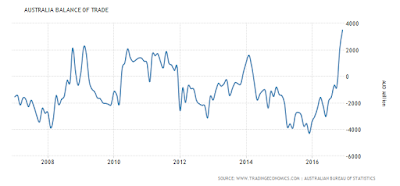The main reason for the boost is that the price of commodities has risen and so have the volume of exports. So Australia has exported more and got more for what they have sold. Chinese demand is crucial in this process.
There are other reasons for the improvement, one being the increased competitiveness of Australian goods and services due to the lower value of the dollar in recent years. However it is mainly commodities and that really is down to China.
Don't get too excited because the Australian Current Account remains in deficit and has been since 1974. The Current Account includes the Balance of Trade, net income and transfers. This clearly implies that the deficit on income and transfers outweighs the Balance of Trade surplus. The graph below shows the Current Account balance for the last ten years to compare with the Balance of Trade above (note that the data for last three months are not yet available below).
There are always implications for of Current Account deficit, such as the effect on Aggregate Demand, a Financial Account surplus, rising foreign debt and the possibility that the country is uncompetitive. A 43 year Current Account deficit suggests the competitivness point has been settled.
This topic is a crucial one for VCE students who should consider the impact on Australia's Net Foreign Debt position and what it says about the country's dependence on China and commodities. IB students will equally be able to use it as an example of International Trade and the wider effects of deficits and surpluses.


No comments:
Post a Comment